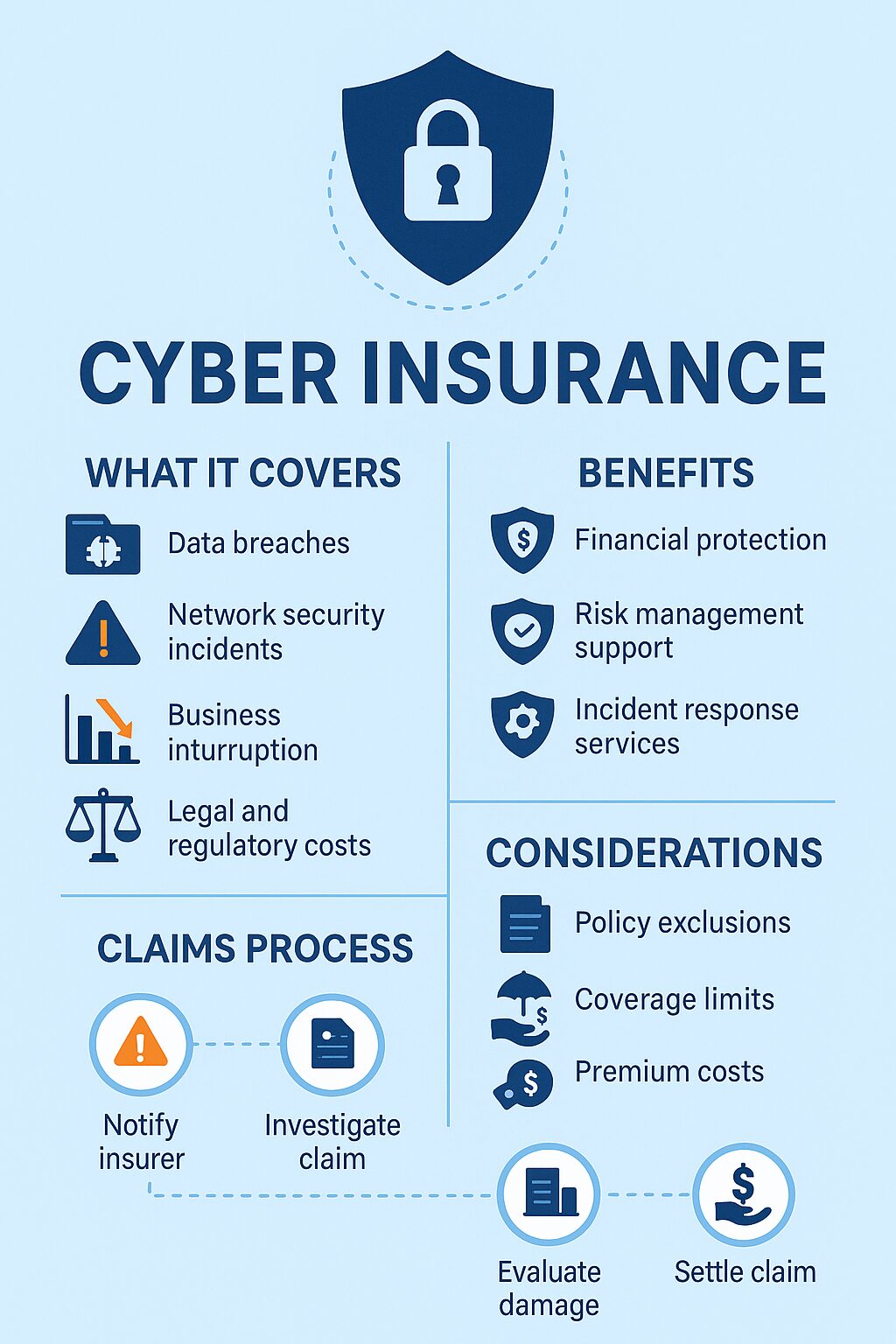Understanding Cybersecurity Insurance in Today’s Digital Landscape
In the era of constant digital transformation, cyberattacks are no longer a matter of if — but when. Even with strong firewalls, endpoint protection, and 24/7 monitoring, no organization is immune to a breach. This reality has driven the rise of cybersecurity insurance — a financial and operational safety net that helps businesses recover from cyber incidents and data breaches.
But the question remains: is cybersecurity insurance worth the investment? Let’s explore how cyber insurance works, what it covers, and how to decide whether it’s right for your business.
What Is Cybersecurity Insurance and What Does It Cover?
Cybersecurity insurance — also known as cyber liability insurance or cyber risk insurance — helps organizations offset the financial and reputational damage caused by cyberattacks.
It functions as a risk transfer mechanism, shifting certain cyber risks from your company to an insurer. Coverage typically includes two categories:
First-Party Coverage
Covers direct costs your company incurs during or after a cyber incident:
- Data recovery and system restoration
- Forensic investigation services
- Ransomware payments (where legally allowed)
- Crisis communication and PR support
- Business interruption losses
- Customer notifications and credit monitoring
- Regulatory fines (where permissible)
Third-Party Liability
Covers damages or legal claims filed by external parties — such as customers, partners, or regulators — following a breach. This often includes:
- Lawsuit defense and settlements
- Privacy violation claims
- Data breach liability
- Contractual breach damages
However, not all policies are equal. Coverage limits, exclusions, and terms vary widely, so understanding what’s included — and what isn’t — is crucial.
💭 If your organization suffered a major data breach tomorrow, could you accurately estimate the financial impact — or would cyber insurance be your only safety net?
Why Businesses Are Investing in Cyber Insurance
Protection Against Financial Losses
A single ransomware attack can cost millions in downtime, data loss, and legal fees. Cyber insurance converts these unpredictable losses into a predictable premium — stabilizing your financial exposure and protecting cash flow during crises.
Immediate Access to Incident Response Experts
Top insurers provide access to specialized teams including:
- Digital forensics and breach response firms
- Cybersecurity law firms
- Public relations and crisis management experts
- Regulatory compliance consultants
Having these professionals on standby drastically reduces response time and damage.
Encouragement of Stronger Security Practices
Before offering coverage, insurers assess your organization’s cybersecurity maturity. This underwriting process incentivizes companies to adopt stronger safeguards like MFA, network segmentation, and regular penetration testing.
In many ways, cyber insurance acts as an accountability tool — improving overall cyber hygiene across industries.
Compliance and Business Confidence
Many contracts and regulatory frameworks (especially in finance, healthcare, and government sectors) now expect or require cyber insurance. Holding an active policy signals to clients, investors, and regulators that your business takes digital risk seriously.
💭 Does your leadership team view cyber insurance as an enabler of resilience — or a checkbox expense?
Challenges and Limitations of Cyber Insurance
While the benefits are clear, cyber insurance is not a substitute for robust cybersecurity practices. Here are the key limitations to consider:
Policy Gaps and Exclusions
Not all cyber events are covered. Common exclusions include:
- Nation-state attacks or “acts of war”
- Known but unpatched vulnerabilities
- Insider misuse or negligence
- Hardware or physical damage
- Failure to maintain required security controls
It’s vital to read the fine print — or work with a knowledgeable broker — to ensure coverage aligns with your actual risk profile.
Rising Premiums and Stricter Underwriting
As global cyberattacks increase, insurers have become more selective. Premiums are rising annually, and policies now require stronger evidence of cybersecurity maturity (e.g., endpoint protection, patch management, and MFA adoption).
Organizations with weak security may face exclusions, limited coverage, or outright denial.
The Moral Hazard Factor
Some executives mistakenly view insurance as a substitute for cybersecurity investment — which can create complacency. However, insurers are increasingly addressing this through performance-based premiums and security audits.
Data and Risk Modeling Limitations
Unlike auto or health insurance, the cyber risk landscape is constantly evolving. The lack of long-term actuarial data makes underwriting complex, leading to coverage ambiguity and price volatility.
💭 What hidden gaps might exist in your current coverage — and how confident are you that your insurer would approve a claim after a major ransomware event?
Is Cyber Insurance Worth the Investment?
The short answer: Yes — for most organizations, it’s a smart investment.
However, its value depends on your business model, data sensitivity, and existing cybersecurity maturity.
Key Benefits
✅ Financial resilience in the event of a breach
✅ Faster recovery with expert support
✅ Improved regulatory and contractual compliance
✅ Enhanced stakeholder confidence
✅ Reinforced cybersecurity culture
When It’s Especially Valuable
Cyber insurance is particularly beneficial if your organization:
- Handles sensitive customer data (e.g., healthcare, finance, retail)
- Relies heavily on online operations or cloud environments
- Operates under strict data protection regulations (HIPAA, PCI-DSS, GDPR)
- Has limited internal resources for incident response
💭 Are you investing more in preventing cyber incidents — or recovering from them? Which approach delivers better long-term ROI?
How to Evaluate a Cyber Insurance Policy
To determine whether a cyber insurance policy is right for your business, follow this six-step framework:
Conduct a Cyber Risk Assessment
Identify your critical assets, potential attack vectors, and the financial impact of a breach. Use frameworks like NIST CSF or ISO 27001 to assess readiness.
Quantify Your Cyber Risk Exposure
Use Cyber Risk Quantification (CRQ) models to estimate probable losses from ransomware, data breaches, and business interruption. This helps determine how much coverage you actually need.
Review Security Maturity
Strengthen controls that insurers evaluate during underwriting:
- Multifactor authentication (MFA)
- Endpoint detection and response (EDR)
- Data encryption and backup management
- Employee security awareness training
- Incident response planning
Compare Multiple Policy Quotes
Look beyond the premium. Compare:
- Coverage limits and sub-limits
- Deductibles or retentions
- Exclusions and “acts of war” clauses
- Crisis response inclusions
- Retroactive date coverage
Layer Your Coverage
Consider combining primary and excess policies to balance affordability and protection. Layering ensures adequate coverage for catastrophic events without overpaying.
Reassess Annually
Cyber risk evolves constantly. Review and renew coverage annually, adjusting terms as your business or threat landscape changes.
Industry Trends and Insights: The Future of Cyber Insurance
Escalating Demand Across All Sectors
According to Munich Re’s 2025 Cyber Outlook, ransomware, business email compromise, and supply chain attacks dominate global claims. As a result, demand for cyber policies continues to surge across SMBs and enterprises alike.
Insurers as De Facto Regulators
Insurance carriers now require minimum security standards before approving coverage. Expect mandatory controls like endpoint protection, patch management, and MFA to become universal.
Advanced Risk Modeling
AI-driven analytics and shared threat intelligence are helping insurers refine pricing and predict losses more accurately. Over time, this will lead to fairer premiums and more tailored coverage.
Emerging Legal and Regulatory Pressures
Governments are increasingly defining how cyber insurance interacts with data privacy laws and ransom payments. This will likely lead to standardized policy language and improved consumer protection.
Best Practices to Maximize the Value of Cyber Insurance
To ensure your cyber insurance investment delivers real ROI, follow these best practices:
- Integrate cyber insurance into your overall risk management strategy. It should complement — not replace — your cybersecurity program.
- Engage leadership early. Include CISOs, CFOs, and legal counsel in the decision process.
- Perform a policy gap analysis. Identify exclusions and close gaps with technical or contractual controls.
- Keep meticulous documentation. Log incidents, patching records, and training evidence to streamline claims.
- Regularly test incident response plans. Many insurers require evidence of tabletop exercises or breach simulations.
- Communicate with your insurer proactively. Update them when new systems, vendors, or geographies are added to your network.
- Educate employees. Human error is still the leading cause of breaches — awareness training reduces both risk and premiums.
Cyber Insurance as a Strategic Investment
Cyber insurance is no longer a luxury — it’s an essential part of modern business resilience.
While it can’t prevent attacks, it provides the financial protection, expert support, and strategic accountability needed to recover quickly when breaches occur.
The real value lies not just in claim payouts, but in the discipline and preparedness it fosters within your organization.
💭 In a world where cyber threats evolve daily, can your business truly afford to be uninsured — or worse, underinsured?


